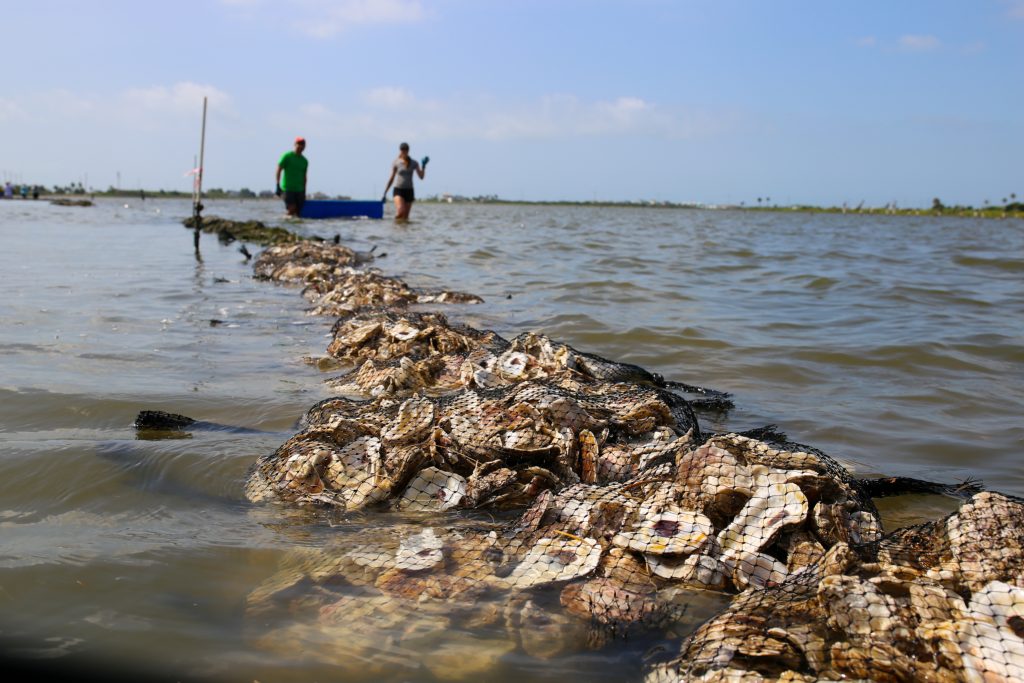Oyster reefs are a vital component of a healthy estuary and provide a unique suite of benefits as a valuable commercial and recreational fishery as well as habitat for other aquatic species. They filter coastal waters, protect shorelines, stabilize sediment, and provide food and shelter for over 300 different species (Grabowski and Peterson, 2007). Unfortunately, oyster reefs are the most threatened marine habitat worldwide. Studies have shown that over 85 percent of oyster habitat has been lost on a global scale (Beck et al, 2011). Heavy exploitation coupled with severe storm events, disease, pollution, and habitat loss has resulted in serious declines in North American oyster populations.
In Galveston Bay, over 60 percent of the oyster reefs have been destroyed, primarily due to decades of heavy exploitation combined with multiple storm events, particularly Hurricanes Ike and Harvey
(Hons and Robinson, 2010). Prior to 2008, Galveston Bay yielded 90 percent of the oyster production in Texas, approximately six million pounds, but since that time “has never topped more than 3.5 million pounds in a year” (Haby et al, 2009; Knapp, 2018; VanderKooy, 2012). In addition, four years (2015-2019) of heavy rainfall events, including Hurricane Harvey, led to extremely low salinity levels and thus a reduction in oyster spawning success. As of 2016, only 700,000 pounds of oysters were harvested in Galveston Bay; this low production is equivalent to only 12 percent of Galveston Bay’s original high yields prior to 2008 (Knapp, 2018).
Although the wild larvae supply in Galveston Bay remains abundant (Martinez-Andrade et al, 2005), the removal of shells from the bay has resulted in a shortage of hard substrate, a key component for sustaining oyster populations. Commercial harvest operations in Galveston Bay, along with storm-driven sedimentation, have reduced the elevation of natural reefs, leaving little to no shell (hard substrate) behind. Unlike finfish, when oysters are harvested their entire habitat, the two valves of their shell and the surrounding oysters, is removed with them.
Hard substrate or “cultch” material, is required for successful oyster development. While oyster larvae can attach to many surfaces such as rock, wood, porcelain, and even tires, multiple studies have shown that oyster shells are the preferred substrate for larval attachment and growth (Coen and Luckenbach, 2000; George et al, 2014). Over the last five to 10 years, it has become increasingly difficult and expensive to purchase oyster shells. In addition, the purchase and placement of rock cultch (e.g. limestone, concrete, river rock) is expensive and often a limiting factor in the size and scope of a reef restoration project. Therefore, sourcing oyster shells from local seafood restaurants or other end users, such as shucking houses, has become the common approach to securing cultch material for the restoration of oyster habitat. Oyster shell recycling began on the East Coast of the United States (US) in the early 2000’s and has expanded along the Gulf Coast over the last 10 years. Now, nearly 30 groups across the US are actively recycling oyster shells including the Galveston Bay Foundation (GBF). Without oyster shell recycling, restaurants will continue to discard oyster shells in their dumpsters and the shells will be lost to landfills, thus squandering a valuable resource.
In response to the decline of Eastern oyster (Crassostrea virginica) habitat in Galveston Bay, GBF initiated an Oyster Shell Recycling Program (OSRP) in 2011. Since then, GBF has expanded its operations through 40 restaurant partnerships and now collects an average of 160 tons (320,000 pounds) of shells a year. Since the inception of the OSRP and as of April 2024, GBF has collected over 1,800 tons (3,600,000 pounds) of oyster shell and returned approximately 800 tons of these recycled shells to Galveston Bay to help replenish hard substrate in the bay and sustain the local oyster population.
–Shannon Batte, GBF

References:
Beck M.W., Brumbaugh R.D., Airoldi L., Carranza A., Coen L.D., Crawford C., Defeo O., Edgar G.J., Hancock B., Kay M.C., Lenihan H.S., Luckenbach M.W., Toropova C.L., Zhang G., and Guo X. (2011). Oyster Reefs at Risk and Recommendations for Conservation, Restoration, and Management. BioScience, 61(2): 107-116.
Coen L.D. and Luckenbach M.W. (2000). Developing success criteria and goals for evaluating oyster reef restoration: ecological function or resource exploitation? Ecological Engineering, 15(3): 323–343.
Grabowski, J.H., and C.H. Peterson. (2007). Restoring oyster reefs to recover ecosystem services. In Ecosystem Engineers, K. Cuddington, J.E. Byers, W.G. Wilson, and A. Hastings (eds). Elsevier Inc., Burlington, MA, 281-298.
Haby, M. G., Miget, R. J., and Falconer, L.L. (2009). Hurricane Damage Sustained by the Oyster Industry and the Oyster Reefs Across the Galveston Bay System with Recovery Recommendations.” A Texas AgriLife Extension Service / Sea Grant Extension Program Staff Paper. The Texas A&M University System, College Station, Tx. TAMU-SG-09-201. 51 pp.
Hons C and Robinson L (2010). Recovering from the Storm: Oyster Reef Restoration in Galveston Bay, Texas. Power Point presentation. 21 pp.
https://www.estuaries.org/pdf/2010conference/monday15/schooner/session3/hons.pdf
Knapp, G. (2018, April 24). The Texas Oyster Industry Is Now a Shell of Its Former Self. Houstonia.
Martinez-Andrade F., Campbell P., Fuls, B. (2005). Trends in relative abundance and size of selected finfishes and shellfishes along the Texas coast: November 1975-December 2003. Austin, Texas: Texas Parks and Wildlife Coastal Fisheries Division. Management Data Series No. 232.